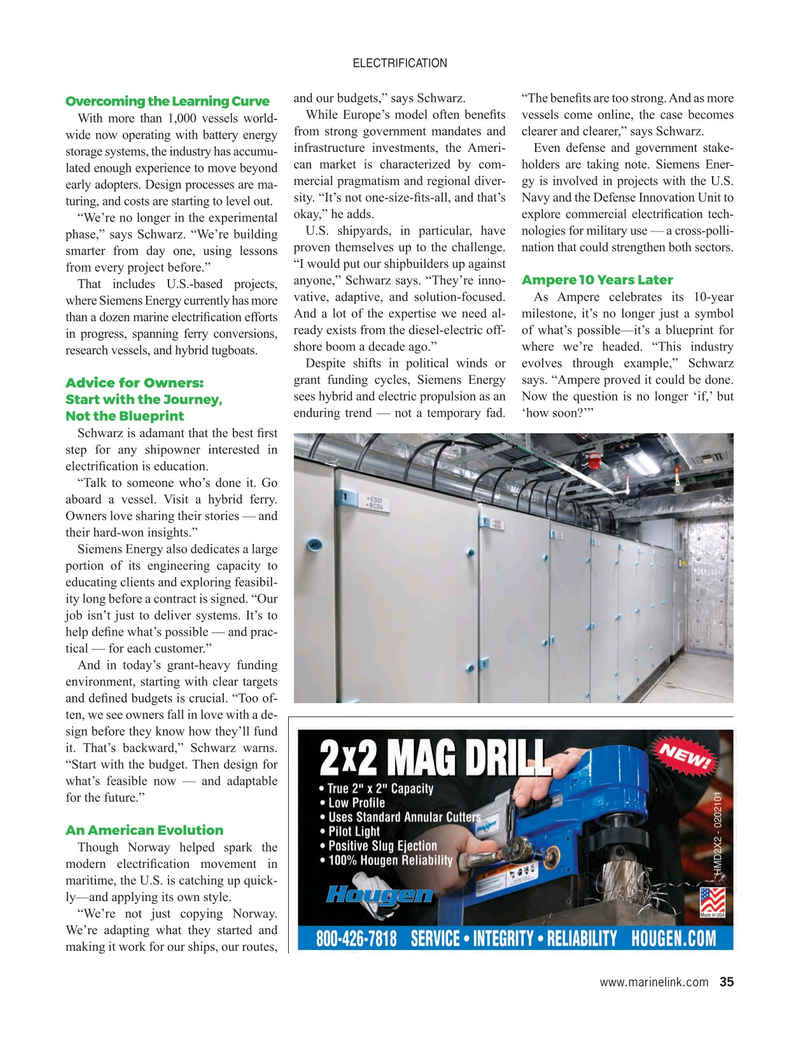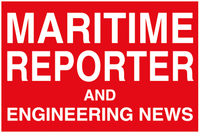
Page 35: of Maritime Reporter Magazine (June 2025)
Read this page in Pdf, Flash or Html5 edition of June 2025 Maritime Reporter Magazine
ELECTRIFICATION and our budgets,” says Schwarz. “The bene? ts are too strong. And as more
Overcoming the Learning Curve
While Europe’s model often bene? ts vessels come online, the case becomes
With more than 1,000 vessels world- wide now operating with battery energy from strong government mandates and clearer and clearer,” says Schwarz.
infrastructure investments, the Ameri- Even defense and government stake- storage systems, the industry has accumu- lated enough experience to move beyond can market is characterized by com- holders are taking note. Siemens Ener- mercial pragmatism and regional diver- gy is involved in projects with the U.S. early adopters. Design processes are ma- sity. “It’s not one-size-? ts-all, and that’s Navy and the Defense Innovation Unit to turing, and costs are starting to level out.
“We’re no longer in the experimental okay,” he adds. explore commercial electri? cation tech-
U.S. shipyards, in particular, have nologies for military use — a cross-polli- phase,” says Schwarz. “We’re building smarter from day one, using lessons proven themselves up to the challenge. nation that could strengthen both sectors.
“I would put our shipbuilders up against from every project before.”
That includes U.S.-based projects, anyone,” Schwarz says. “They’re inno- Ampere 10 Years Later vative, adaptive, and solution-focused. As Ampere celebrates its 10-year where Siemens Energy currently has more than a dozen marine electri? cation efforts And a lot of the expertise we need al- milestone, it’s no longer just a symbol in progress, spanning ferry conversions, ready exists from the diesel-electric off- of what’s possible—it’s a blueprint for shore boom a decade ago.” where we’re headed. “This industry research vessels, and hybrid tugboats.
Despite shifts in political winds or evolves through example,” Schwarz grant funding cycles, Siemens Energy says. “Ampere proved it could be done.
Advice for Owners: sees hybrid and electric propulsion as an Now the question is no longer ‘if,’ but
Start with the Journey, enduring trend — not a temporary fad. ‘how soon?’”
Not the Blueprint
Schwarz is adamant that the best ? rst step for any shipowner interested in electri? cation is education.
“Talk to someone who’s done it. Go aboard a vessel. Visit a hybrid ferry.
Owners love sharing their stories — and their hard-won insights.”
Siemens Energy also dedicates a large portion of its engineering capacity to educating clients and exploring feasibil- ity long before a contract is signed. “Our job isn’t just to deliver systems. It’s to help de? ne what’s possible — and prac- tical — for each customer.”
And in today’s grant-heavy funding environment, starting with clear targets and de? ned budgets is crucial. “Too of- ten, we see owners fall in love with a de- sign before they know how they’ll fund it. That’s backward,” Schwarz warns. “Start with the budget. Then design for what’s feasible now — and adaptable for the future.”
An American Evolution
Though Norway helped spark the modern electri? cation movement in maritime, the U.S. is catching up quick- ly—and applying its own style.
“We’re not just copying Norway.
We’re adapting what they started and making it work for our ships, our routes, www.marinelink.com 35
MR #6 (34-45).indd 35 MR #6 (34-45).indd 35 5/31/2025 9:46:59 PM5/31/2025 9:46:59 PM

 34
34

 36
36
